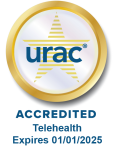Common questions about the coronavirus
As the nation’s stay-at-home guidelines phase out, and people head back to some sort of new normal, COVID-19 remains a risk. UCM’s Virtual ER team is available 24 hours a day, seven days a week to treat and triage patients on a variety of emergency medical issues, including symptoms of the coronavirus. Here, we’re answering some of the common COVID-related questions with help from our Chief Medical Officer, Dr. Michael Bibighaus, M.D.
Can I get a COVID-19 test?
Should the concern for a case of the coronavirus arise, our team will follow protocols set by healthcare authorities and work with local EMS and hospitals to ensure the patient receives immediate response and the right care, without potentially infecting others. Our emergency medical providers will alert our Care Coordinators to a patient’s need for a COVID-19 test, and the Care Coordinators will work to locate a nearby testing location and schedule a test for the patient. Because testing is performed via a nasal swab, and not through a blood test, the locations where this testing occurs is limited. Our care coordinators know where to find where this testing occurs in your area and can assist in scheduling a test.
RNA Nasal swabs that are claiming generally up to 95 percent sensitivity and specificity are done only with patients whom are symptomatic or whom have been mandated to do so. In order to increase the effectiveness of any nasal swab, make sure the person performing the test on you stays deep in the nostril for at least 10 seconds and that they obtain actual mucus on the swab before they are finished. You may have to have both nostrils swabbed.
What about an antibody test?
IGM and IGG antibody screenings are done to identify if patients have acute COVID infection antibodies (IGM antibodies) versus IGG antibodies that are present in patients whom had a COVID infection and have “presumed” immunity to the virus.
At this point, it is unknown if all infected patients mount a protective immune response and how long any protective effect will last. Antibody testing is easily obtained at most commercial labs via a blood test. UCM can order these tests. It is important to remember, however, that these tests were designed for surveillance and research purposes with the goal of determining the percentage of the population who may have been infected. “The results of these tests at this time should not be used in back-to-work decisions and should not give individuals that test positive for antibodies the false hope that they cannot be infected again or ignore public health recommendations in regards to social distancing and hygiene,” cautions Dr. Bibighaus.
Should I buy a pulse oximeter?
A pulse oximeter helps assess your breathing by measuring the oxygen saturation of arterial blood, and it also measures your heart rate. Many COVID-19 patients experience Hypoxemia, a below-normal level of oxygen in the blood that is often a sign of a problem related to breathing or circulation, specifically in the arteries, and may result in various symptoms, such as shortness of breath. (specific information on pulse oximetery and Hypoxemia from the Mayo Clinic)
Because of this, many people are looking to purchase a pulse oximeter for at-home use. Purchasing your own pulse oximeter is probably not necessary for the majority of our patients. However, if you are interested in checking your oxygen saturation there are many free or low-cost apps that you can download to your smart phone. In general, you cover your phone’s camera and flash with your finger and the app provides your pulse ox and heart rate. “We get concerned with a pulse ox less than 93% — but that number needs to be viewed in the context of the whole patient and their symptoms. If you have any questions, please give our providers a call,” explains Dr. Bibighaus.
With an at-home pulse oximeter, the suggestion is that patients measure their oxygen level twice daily, or when short of breath. It should also be noted that an at-home pulse-oximeter is certainly helpful, but simply noting increased need for breathing when talking is also a good way to determine a shortness of breath.
How do I know if my thermometer is accurate?
A high body temperature — a fever — indicates that the body is fighting something, often an illness. When a patient is running a fever, it is important measure temperature twice a day. However, it is advised to take the average of three measurements each time, as there are not perfectly operating home thermometers. Here are the three types of thermometers most commonly found in a home, along with information on each, provided by the Mayo Clinic:
- Digital thermometers: Regular digital thermometers use electronic heat sensors to record body temperature. Most digital thermometers can record temperatures from the mouth, armpit or rectum — often in a minute or less. A digital thermometer is appropriate for newborns, infants, children and adults. Digital ear thermometers, also called tympanic thermometers, use an infrared ray to measure the temperature inside the ear canal. Note: If your child uses a pacifier, you might want to try a digital pacifier thermometer. Your child simply sucks on the pacifier until the peak temperature is recorded.
- Forehead thermometers, or temporal artery thermometers: Temporal artery thermometers — often sold as forehead thermometers — use an infrared scanner to measure the temperature of the temporal artery in the forehead. Temporal artery thermometers can record a person’s temperature quickly and are easily tolerated.
- Mercury thermometers: Once a staple in most medicine cabinets, mercury thermometers use mercury encased in glass to measure body temperature. Mercury thermometers are no longer recommended because they can break and allow mercury — which is toxic — to escape.
A reminder: wash your hands
As always, please diligently wash your hands with warm water and soap regularly, for at least 20 seconds and cough or sneeze into the crook of your elbow, not your hand. Avoid contact between hands and the face or mouth, and wear a mask when appropriate to reduce community spread. Use good common sense in crowds – avoid them if possible, but use hand sanitizer/good hand washing techniques following time in the public, and avoid handshakes and hugs.
Have more questions about COVID-19? Send us an email and we’ll post your questions and the answers from Dr. Bibighaus and his team here and on our social media pages!






